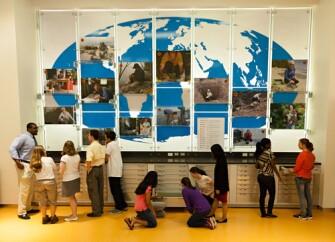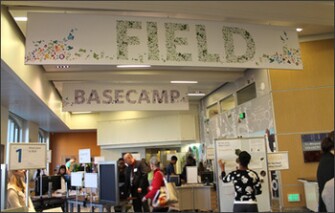
A new learning space opened this week at the Smithsonian Institution’s National Museum of Natural History that aims to provide hands-on opportunities for getting young people engaged with science, with a special focus on teenagers.
“Museums are places that flick that switch of curiosity,” museum director Kirk Johnson said at a Dec. 12 event to unveil the new space.
The facility is tailored to connect teens’ everyday experiences to science.
“Through conversations with scientists and hands-on interactions with thousands of authentic museum specimens and objects, Q?rius (pronounced curious) visitors will experience how science is relevant to them and how they can develop the skills to become the scientists of tomorrow,” a press release explains.
The learning center includes seven distinct exhibits where visitors can pursue a wide range of activities, examining everything from coral reefs to Mars. They also will have the opportunity to examine collections using the same scientific instruments as Smithsonian researchers.
Additionally, Natural History Investigations, one component of the initiative, offers group-oriented programs that include 60-minute workshops that allow for in-depth explorations of areas in natural science applicable to school curricula.
Not every student will make it to Washington to check out the facility, so teens also can also visit a new website that offers a wealth of resources and activities. They can start by creating their own field books as a way to document their Q?rius discoveries. They can also read stories about scientific topics, including biodiversity, volcano eruptions, and mass extinctions. Then, visitors can watch science unfold through videos that place viewers in the mix of scientific discovery and exploration. Through these videos, teens can now dive under Arctic ice with researchers, excavate the fossil of an extinct whale, or even participate in a webcast.
The new website also acts as a resource for upcoming events and special programs for individuals or classes and lets groups register online. There is also information about internship and volunteer programs with Q?rius.
“We want to create authentic experiences for teens to connect to the natural world,” said Shari Webb, an assistant director for education and outreach at the museum, said at the event unveiling the new center. “We wanted to be a place relevant to teens.”

And the time students spend learning outside of their classrooms at the Q?rius center won’t go unrecognized. Visitors will be able to earn digital badges, which allow them to document their learning experiences with Q?rius program.
The new center at the Museum of Natural History is just one of many science centers and museums around the nation that offer the potential for powerful learning experiences outside the classroom. Education Week has previously reported museums and centers taking the reins in supplementing students’ science curriculum. A 2011 story featured Albuquerque’s Explora science center, which has worked over the years to attract young people and families for learning opportunities, and has partnered with local school districts.
The story went on to explain the important role that science-rich institutions can play in addressing the nation’s science curriculum and the curiosity that science centers, museums, botanical gardens, zoos, and aquariums can inspire.
Images: Top photo by James Di Loreto, provided by the Smithsonian Institution. Bottom photo by Alyssa Morones.